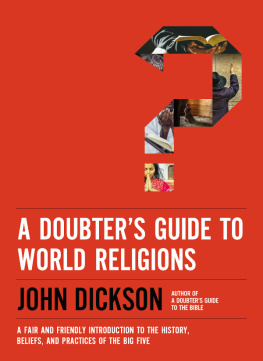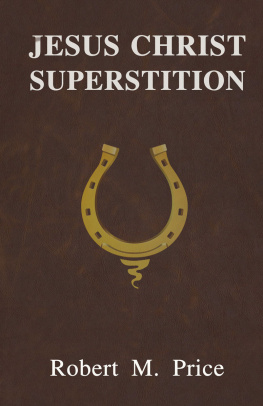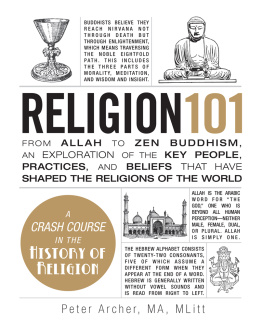CURIOSITIES OF SUPERSTITION
AND SKETCHES OF SOME UNREVEALED RELIGIONS
* * *
W. H. DAVENPORT ADAMS
*
Curiosities of Superstition
And Sketches of Some Unrevealed Religions
First published in 1882
ISBN 978-1-62013-109-1
Duke Classics
2013 Duke Classics and its licensors. All rights reserved.
While every effort has been used to ensure the accuracy and reliability of the information contained in this edition, Duke Classics does not assume liability or responsibility for any errors or omissions in this book. Duke Classics does not accept responsibility for loss suffered as a result of reliance upon the accuracy or currency of information contained in this book.
Contents
*
Curiosities of Superstition
*
"To my mind there is no study more absorbing than that of the Religions of the World,the study, if I may so call it, of the various languages in which man has spoken to his Maker, and of that language in which his Maker 'at sundry times and in divers manners' spake to man."MAX MLLER.
"Primus in orbe Deos fecit timor."STATIUS, Thebaid, 661.
Chapter I - Buddhism: Its Origin and Ceremonies
*
PRAYER-WHEELS OF THE BUDDHISTS.
Travelling on the borders of Chinese Tartary, in the country of the Lamasor Buddhists, Miss Gordon Cumming remarks that it was strange, every nowand again, to meet some respectable-looking workman, twirling little brasscylinders, only about six inches in length, which were incessantlyspinning round and round as they walked along the road. What could theybe? Not pedometers, not any of the trigonometrical instruments with whichthe officers of the Ordnance Survey go about armed? No; she was informedthat they were prayer-wheels, and that turning them was just aboutequivalent to the telling of beads, which in Continental lands workmen mayoften be seen counting as homeward along the road they plod their wearyway.
The telling of beads seems to the Protestant a superfluous piece offormalism: what then are we to think of prayer by machinery? The prayers,or rather invocations, to Buddhathe Buddhists never pray, in theChristian senseare all closely written upon strips of cloth or paper;the same sentence being repeated some thousands of times. These strips areplaced inside a cylinder, revolving on a long spindle, the end of which isthe handle. From the wind-cylinder depends a small lump of metal, which,whirling round, communicates the necessary impetus to the little machine,so that it rotates with the slightest possible effort, and continues togrind any required number of acts of worship, while the owner, with theplaything in his hand, carries on his daily work. His religion requiresthat he should be all his time immersed in holy contemplation of theperfections of Buddha, but to a busy man no such self-absorption ispossible. He is content, therefore, to say the sentences aloud at thebeginning and end of his devotions, and in the interval twirls slowly,while a tiny bell marks each rotation, and reminds him if he shouldunconsciously quicken his pace.
Tennyson finely speaks of Prayer as that by which
"The whole round world is every way
Bound by gold chains around the feet of GOD;"
but no such efficacy can be ascribed to the cylinders of brass, copper, orgold, which are fashionable among the Buddhists. Yet we must not condemntoo unreservedly: Prayer, even among Christians, is apt to degenerate intoa dull, mechanical uniformity, and to become scarcely less perfunctorythan that which the Tibetans grind out of their prayer-machine.
In a Lama temple, Miss Gordon Cumming once saw a colossal prayer-wheel,which might almost have sufficed for the necessities of a nation. It wasturned by a great iron crank, which acted as a handle. The cylindermeasured about twelve feet in height, and six to eight feet in diameter.Circular bands of gold and vermilion adorned it, each band bearing thewell-known Buddhist ascription, or invocation, "To the jewel on theLotus." Of this inscription, multiplied on strips of paper and cloth, thecylinder was full, and each time that it revolved on its axis, the devoteewas accredited with having uttered the pious invocation just as often asit was repeated within the cylinder. The whole history of Superstitionoffers scarcely any fact more curious or suggestive than this method ofprayer by machinery; and that such a grotesque extravagance should haveemanated from so subtle and metaphysical a faith as Buddhism is an anomalynot easily to be explained.
Each votary who is too poor to possess a prayer-wheel of his own, attendsthe temple, does homage to the head Lama, receives his benediction, andthen, squatting in front of the great wheel, he turns the crank on behalfof himself and his family. But if there be a considerable number ofworshippers, the priest himself works the handle, that all may participatesimultaneously in the act of prayer.
The use of these machines is traced back for fully fourteen centuries, andis supposed to have originated in the belief that it was a meritoriousact, and a patent cure for sin, to be continually reading or recitingportions of the sacred books of Buddha. But as many of the people couldnot read, a substitute had to be found, and it came to be consideredsufficient if they turned over the rolled manuscripts which embodied theinvaluable precepts. And as a vast amount of time and trouble was saved bythis process, a further simplification became possible and popular,theinvention of wheels termed Tehu-Chor,great cylindrical bands full ofprayers; a cord being attached to the base of the band, which, when thecord was pulled, twirled like a children's toy. Prayer-wheels of this kindare set up in all public places in Tibet, so that the poor who do notpossess little pocket Wheels of Devotion may not lose their chance ofaccumulating merit. In some of the monasteries the rows of small cylindersare so arranged, that the priest, or any passer-by can set them all insimultaneous motion, by just drawing his hand along them.
According to Miss Cumming, who is confirmed by other travellers, thecylinders vary in size, from tiny hand-mills, about as big as apoliceman's rattle, to huge machines, eight or ten feet in diameter,worked by a heavy iron crank, or sometimes by wind or water power. Thewind prayer-mills are turned by wings, which, like the cylinder, areplentifully covered with prayers. The water-mills are placed over streams,so as to dispense with human aid, and allow the running water to turn themfor the general welfare of the village. Through the cylinder passes awooden axle, which is fastened to a horizontal wheel, whose cogs areturned diagonally to the water.
"One such group of little mills we noticed," says Miss Cumming, "set ina clear stream half-way between Rarung and Pangi, a lively, rapid river,rushing headlong down the mountain side to join the Sutlej. Having neverthen heard of prayer-mills, we assumed them to be for corn, as perhapsthey were. At all events, we passed them without inspection, to oursubsequent infinite regret. These wheels rotate with the action of thewater, and so turn the cylinder, which must invariably stand upright.Sometimes several of these are placed almost across the stream, and therudest form of temple is built over them.
"They are so placed that the wheel must invariably turn from right toleft, following the course of the sun; to invert that course would notonly involve ill-luck, but would amount to being a sin. Hence theexceeding unwillingness of the people we met to let us tend their littlewheels, knowing from sad experience that the English sahibs rather enjoythe fun of turning them the wrong way, and so undoing the efficacy of alltheir morning's work.












